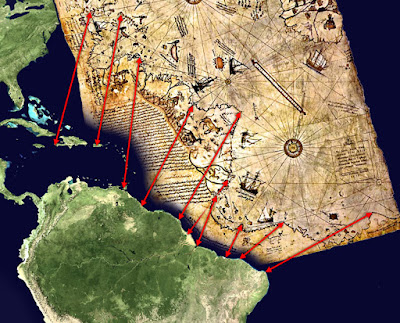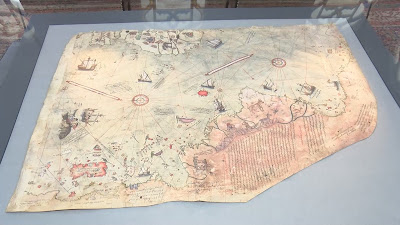The enigmatic Piri Reis Map has been a source of fascination and debate for scholars, historians, and cartographers alike. Its discovery in 1929 by Gustav Deissmann sparked a journey into the unknown, unveiling a world that defied conventional understanding. As we delve deeper into its intricacies and implications, the map opens doors to a multitude of possibilities, shattering the boundaries of our knowledge and challenging the narratives of our history.
The presence of Antarctica on the Piri Reis Map, a landmass that was not officially discovered until 300 years later, raises profound questions about the origins of this knowledge. How could Piri Reis, drawing on sources from ancient civilizations such as the Greeks and Portuguese, have depicted Antarctica without its icy covering? Was there a lost civilization, existing thousands of years ago, that possessed advanced navigational skills and the ability to chart the globe with remarkable accuracy? The inclusion of Antarctica before its transformation into an icy wilderness hints at the existence of an ancient world far more technologically advanced than previously imagined.
Moreover, the utilization of the Mercator Projection, a mapping technique not introduced until the late 16th century, adds an additional layer of mystery to the Piri Reis Map. How could Piri Reis have employed a methodology that was ahead of his time? Did he have access to knowledge and resources that have since been lost to history? Or does this point to the influence of extraterrestrial beings who imparted their advanced understanding of cartography to ancient civilizations? The enigmatic origins of the Mercator Projection on the map continue to bewilder researchers, leaving ample room for speculation and intrigue.
While skeptics argue that the landmass depicted on the Piri Reis Map is simply an accurate representation of the South American coastline, the existence of other maps resembling an ice-free Antarctica raises questions about this interpretation. Could it be that Piri Reis was indeed depicting Antarctica, and that our understanding of its history and formation is incomplete? The possibility of a prehistoric civilization that had a profound understanding of the Earth's geography, possessing not only navigational and cartographic skills but also aerial capabilities, leads to tantalizing conjectures. Some even connect these theories to the legendary lost city of Atlantis, envisioning a technologically advanced society that thrived in the depths of antiquity.
Charles Hapgood, with his book "Maps of the Ancient Sea Kings," presented compelling theories about the Piri Reis Map and its implications. His notion of a prehistoric civilization predating 4000 BCE, capable of circumnavigating the globe and accurately charting its lands, challenges conventional timelines and calls into question the trajectory of human development. Although some of Hapgood's hypotheses have been dismissed, his work ignites the imagination and encourages us to explore alternative possibilities in our quest to understand the secrets hidden within the ancient world.
As we stand at the crossroads of knowledge and uncertainty, the Piri Reis Map reminds us of the boundless mysteries that lie in wait. It beckons us to cast off the shackles of conventional thinking and embrace the idea that our past may hold wonders and truths beyond our current comprehension. While the true nature and origin of the map remain elusive, its existence alone stirs our curiosity and sparks a thirst for discovery.
The journey to decipher the secrets of the Piri Reis Map is far from over. The pursuit of definitive evidence and a comprehensive understanding continues, as researchers, historians, and enthusiasts delve into the depths of antiquity. With each revelation and each unanswered question, the map invites us to revaluate our perceptions of history, to reconsider the capabilities of ancient civilizations, and to embrace the awe-inspiring notion that our world may have been shaped by forces far more extraordinary than we ever imagined.
In the end, the significance of the Piri Reis Map extends far beyond its enigmatic features. It challenges us to question the limits of human achievement and the depth of our understanding of the past. The map serves as a potent symbol of our ceaseless pursuit of knowledge and the unending quest to unravel the mysteries of our world.
As technology advances and new discoveries emerge, we may eventually find the key to unlock the secrets held within the Piri Reis Map. It is a testament to the resilience of human curiosity and the indomitable spirit of exploration. The map reminds us that history is not a static entity but a living, evolving narrative waiting to be discovered and rewritten.
Whether the Piri Reis Map depicts an ancient advanced civilization, an otherworldly influence, or a mere coincidence of cartographic representation, its allure remains undiminished. It urges us to embrace the unknown, to challenge established paradigms, and to acknowledge that there is still much we do not comprehend about our own past.
The journey to understand the Piri Reis Map is an ongoing voyage of discovery, where each revelation is a stepping stone toward a greater understanding of our shared human heritage. It encourages collaboration and interdisciplinary exploration, as researchers from various fields come together to unravel the mysteries concealed within its intricate lines and symbols.
Ultimately, the Piri Reis Map invites us to contemplate the vastness of our world and the rich tapestry of civilizations that have shaped it. It reminds us that history is not confined to textbooks and archives but is a living, breathing entity that constantly surprises and challenges us.
So let us embark on this intellectual odyssey, driven by a thirst for knowledge and a reverence for the wonders of the past. Let us delve into the depths of antiquity, guided by the enigmatic Piri Reis Map, and embrace the notion that our world is far more extraordinary than we ever imagined.
Articles you might like:




No comments:
Post a Comment